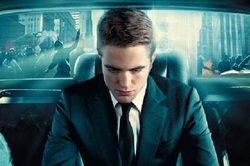
However, this post isn’t about the film’s ideas but its structural form. What happens in the films is that a central character spends a day travelling about a big city in his stretch limousine in search of a haircut. He meets a range of other characters, some inside the car, others in public places.
This kind of structure belongs to a family of parallel narrative that I’ve named consecutive stories, (I describe it as ‘one story coming after another and linking at the end’). Specifically, Cosmopolis belongs to the simplest form of consecutive stories, which I’ve named ‘Stories walking into the picture’ (the fine Iranian film The Circle is another example). Stories walking into the picture is exactly what it says. It’s a kind of ‘fly on the wall’ film, involving a series of (usually) self contained stories, one taking over from another, as one character, or even just the camera, moves physically through an environment.
The big problem of stories walking into the picture is that it is inherently slow. Unless you insert some genuine suspense into the stories that are told one after the other, or somehow link them together so that they are rising to a climax you can easily get the boring effect of ‘and then... and then... and then...’. Unfortunately, Cosmopolis doesn’t succeed in inserting any rising suspense across its stories (apart from a little at the end about a murder attempt).
Now, interestingly, very suspenseful films like Pulp Fiction and City of God belong to ‘stories walking into the picture’. So how do they achieve suspense? They use non linearity. This is crucial. Both films get enormous energy by making one of their storylines non linear, so that the film opens at a highly suspenseful, violent moment. The consectuive complete stories are then inserted into this fractured frame. In Pulp Fiction we don’t return to the initial fractured story until all of the other stories are told. In City of God we keep visiting the fractured story throughout the film. In both instances it’s specifically this non linearity that prevents the slowness that you get in the linear form. The non linearity injects mysetery and suspense. So a fractured storyline might well have given Cosmopolis some more energy and meaning. Fracturing is thus a good trick to remember if you are thinking of using stories walking into the picture.
On the matter of energy, I think Cosmopolis might have found more of if had the journey through the city had a stronger and more interesting motive. There is a quick trick to finding motive in this kind of situation. When I talk about multiple protagonist stories (group missions, sieges or reunions) I suggest that writers will get a more powerful and driven story if, instead of thinking ‘a group of characters gets together AND ‘,the writer thinks ‘a group of characters gets together BECAUSE’. I think Cosmopolis could have had more suspense and impact had the writers approached the film not as ‘a man gets in a car and travels across a city AND ... ‘ but ‘a man gets into a car and travels around a city BECAUSE...’
 RSS Feed
RSS Feed


